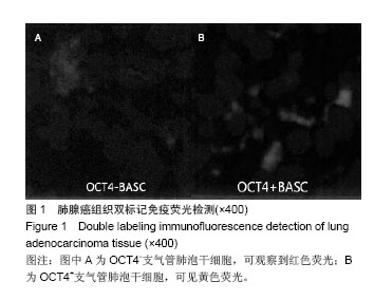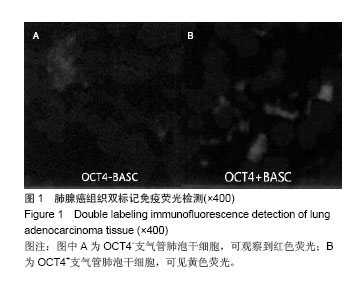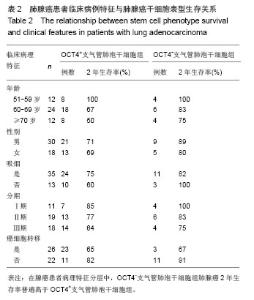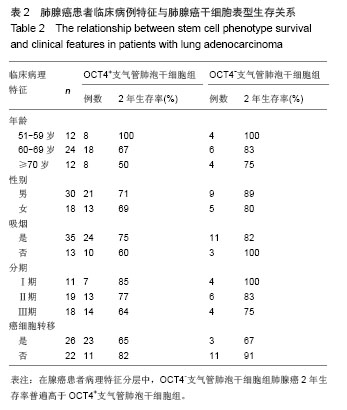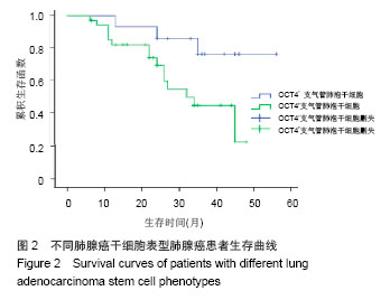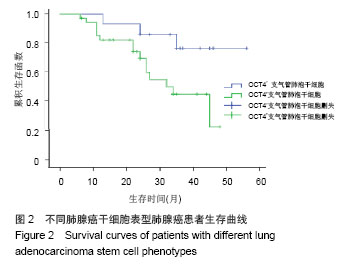Chinese Journal of Tissue Engineering Research ›› 2015, Vol. 19 ›› Issue (10): 1523-1527.doi: 10.3969/j.issn.2095-4344.2015.10.009
Previous Articles Next Articles
Human lung adenocarcinoma stem cell phenotypes and patient’s prognosis
Maierdan Sailimu1, Alidan Erkin2, Jin Zhong1, He Tie-han1
- 1Department of VIP, 2Department of General Family Medicine, the First Affiliated Hospital of Xinjiang Medical University, Urumqi 830054, Xinjiang Uygur Autonomous Region, China
-
Online:2015-03-05Published:2015-03-05 -
Contact:He Tie-han, Chief physician, Department of VIP, the First Affiliated Hospital of Xinjiang Medical University, Urumqi 830054, Xinjiang Uygur Autonomous Region, China -
About author:Maierdan Sailimu, Master, Physician, Department of VIP, the First Affiliated Hospital of Xinjiang Medical University, Urumqi 830054, Xinjiang Uygur Autonomous Region, China
CLC Number:
Cite this article
Maierdan Sailimu, Alidan Erkin, Jin Zhong, He Tie-han. Human lung adenocarcinoma stem cell phenotypes and patient’s prognosis[J]. Chinese Journal of Tissue Engineering Research, 2015, 19(10): 1523-1527.
share this article
| [1]Shi MM, Xiong YL, Jia XS, et al. Fluorouracil selectively enriches stem-like cells in the lung adenocarcinoma cell line SPC. Tumour Biol. 2013;34(3):1503-1510. [2]Shimada Y, Saji H, Nomura M, et al. Cancer stem cell-related marker expression in lung adenocarcinoma and relevance of histologic subtypes based on IASLC/ATS/ERS classification. Onco Targets Ther. 2013;6:1597-1604. [3]Huang Y, Zeng F, Xu L, et al. Anticancer effects of cinnamic acid in lung adenocarcinoma cell line h1299-derived stem-like cells. Oncol Res. 2013;20(11):499-507. [4]原薇薇,谭艳,杜敏,等. HOXB7基因在肺腺癌中的表达及其临床意义[J]. 临床肿瘤学杂志, 2014,19(11):987-991. [5]卞春安,许有涛,王洁,等. p16和Smad4表达缺失在肺腺癌预后的意义[J]. 中华实验外科杂志, 2014,31(10):2310-2313. [6]王艺芳,刘奔,刘纯青,等. Bmi-1-siRNA抑制肺腺癌SPC-A1细胞的增殖及其机制[J]. 中国癌症杂志, 2014,24(5):333-341. [7]李鹏飞,吕慧娜,韩立波. 转录因子Oct4、Sox2在人肺癌中的表达及其临床意义[J].山东医药, 2012,52(20):79-81. [8]Lotz S, Goderie S, Tokas N, et al. Sustained levels of FGF2 maintain undifferentiated stem cell cultures with biweekly feeding. PLoS One. 2013;8(2):e56289. [9]汤夏冰,李蕾,沈晓辉,等.干细胞转录因子SOX2和OCT4在喉癌中的表达及与预后的关系[J].实用医学杂志, 2013,29(5): 751-753. [10]Wu X, Chen H, Wang X. Can lung cancer stem cells be targeted for therapies. Cancer Treat Rev. 2012;38(6): 580-588. [11]张云.利用肺癌细胞特异性结合肽建立检测肺癌的免疫酶法[D].合肥: 安徽医科大学,2014. [12]邵建伟,陆一鸣,韩宝惠,等.正常肺及肺腺癌组织中细支气管肺泡干细胞相关指标的表达[J].中国医药,2014,9(1):27-31. [13]许可.对非小细胞肺癌上皮间质转化及化疗敏感性的影响[D]. 沈阳:中国医科大学,2013. [14]白晓燕. Hedgehog信号通路在EGFR-TKI敏感和耐药非小细胞肺癌细胞中的作用机制研究[D]. 广州:南方医科大学,2013. [15]刘芃芃,于文文,程亚楠,等.基于3D细胞培养系统的肺癌类干细胞的分离和鉴定[J].中国肿瘤临床,2014,41(16):1013-1016. [16]夏晖,于长海,张文,等.人肺癌A549细胞系肿瘤干细胞的筛选和鉴定[J].中国肺癌杂志,2013,16(8):400-404. [17]梁冬. RNA干扰HiWi基因对肺癌干细胞增殖、凋亡的影响[D]. 哈尔滨:哈尔滨医科大学, 2011. [18]刘晓丽.噬菌体展示EpCAM单链抗体的制备及其靶向肺腺癌细胞的初步研究[D].重庆:第三军医大学,2011. [19]谭思创,王若星,谭斯品,等.人肺腺癌肿瘤细胞免疫表型CD133、CD34、CD44的实验研究[J].中国医师杂志,2011,13(5):592-595. [20]周菁. Bmi1基因在肺腺癌干细胞样细胞自我更新、增殖中作用的在体研究[D]. 重庆:第三军医大学, 2011. [21]谢伟.人卵巢癌细胞系A2780的肿瘤干细胞的分离培养和鉴定[D]. 重庆:第三军医大学, 2011. [22]Hassan KA, Wang L, Korkaya H, et al. Notch pathway activity identifies cells with cancer stem cell-like properties and correlates with worse survival in lung adenocarcinoma. Clin Cancer Res. 2013;19(8):1972-1980. [23]薛明明,宁仁利,黄进肃,等.人肺腺癌干细胞分子表型及PLAGL2基因的生物学功能研究[J].中国细胞生物学学报, 2012,34(4): 366-375. [24]刘天舒,毛志福,刘军韬,等. Notch信号通路在肺癌干细胞中的表达及其对增殖的影响[J].中华实验外科杂志,2015,32(1):84-87. [25]Fan X, Khaki L, Zhu TS, et al. NOTCH pathway blockade depletes CD133-positive glioblastoma cells and inhibits growth of tumor neurospheres and xenografts.Stem Cells. 2010;28(1):5-16. [26]Li Z. CD133: a stem cell biomarker and beyond. Exp Hematol Oncol. 2013;2(1):17. [27]El-Khattouti A, Sheehan NT, Monico J, et al. CD133? melanoma subpopulation acquired resistance to caffeic acid phenethyl ester-induced apoptosis is attributed to the elevated expression of ABCB5: significance for melanoma treatment. Cancer Lett. 2015;357(1):83-104. [28]Akita M, Tanaka K, Matsumoto S, et al. Detection of the Hematopoietic Stem and Progenitor Cell Marker CD133 during Angiogenesis in Three-Dimensional Collagen Gel Culture. Stem Cells Int. 2013;2013:927403. [29]赵建国,熊建萍.非小细胞肺癌驱动基因研究进展[J].中国肺癌杂志,2015,18(1):42-47. [30]Shi J, Shi W, Ni L, et al. OCT4 is epigenetically regulated by DNA hypomethylation of promoter and exon in primary gliomas. Oncol Rep. 2013;30(1):201-206. [31]Liu D, Zhou P, Zhang L, et al. HPV16 activates the promoter of Oct4 gene by sequestering HDAC1 from repressor complex to target it to proteasomal degradation. Med Hypotheses. 2012;79(4):531-534. [32]Kashyap V, Rezende NC, Scotland KB, et al. Regulation of stem cell pluripotency and differentiation involves a mutual regulatory circuit of the NANOG, OCT4, and SOX2 pluripotency transcription factors with polycomb repressive complexes and stem cell microRNAs. Stem Cells Dev. 2009; 18(7):1093-1108. [33]Karoubi G, Gugger M, Schmid R, et al. OCT4 expression in human non-small cell lung cancer: implications for therapeutic intervention. Interact Cardiovasc Thorac Surg. 2009;8(4): 393-397. [34]Zhang X, Han B, Huang J, et al. Prognostic significance of OCT4 expression in adenocarcinoma of the lung. Jpn J Clin Oncol. 2010; 40(10):961-966. [35]Hu T, Liu S, Breiter DR, et al. Octamer 4 small interfering RNA results in cancer stem cell-like cell apoptosis.Cancer Res. 2008; 68(16):6533-6540. [36]陈琛,孟凡荣,万海粟. MicroRNAs与OCT4基因之间的相互作用[J].中国肺癌杂志,2015,18(1):55-58. [37]Stevenson M, Mostertz W, Acharya CR, et al. Retraction: characterizing the clinical relevance of an embryonic stem cell phenotype in lung adenocarcinoma. Clin Cancer Res. 2012; 18(6):1818. [38]Chen Z, Wang T, Cai L, et al. Clinicopathological significance of non-small cell lung cancer with high prevalence of Oct-4 tumor cells. J Exp Clin Cancer Res. 2012;31:10-19. [39]Takahashi A, Hirohashi Y, Torigoe T, et al. Ectopically expressed variant form of sperm mitochondria-associated cysteine-rich protein augments tumorigenicity of the stem cell population of lung adenocarcinoma cells. PLoS One. 2013; 8(11):e69095. [40]邵建伟,陆一鸣,韩宝惠,等.正常肺及肺腺癌组织中细支气管肺泡干细胞相关指标的表达[J].中国医药,2014,9(1):27-31. [41]尹晓玲,王正中,赵银晶,等.人IL-12/慢病毒重组体对结肠癌干细胞“干性”的影响[J].中国免疫学杂志, 2013,29(2):161-167. [42]Lee ST, Gong SP, Yum KE, et al. Transformation of somatic cells into stem cell-like cells under a stromal niche. FASEB J. 2013;27(7):2644-2656. [43]张杰.肺腺癌IASLC/ATS/ERS国际多学科分类临床应用中的若干问题与思考[J].诊断病理学杂志, 2012,19(6):401-405. [44]雷宇,金问森,陈先平,等.丹皮酚对人肺腺癌A549细胞放射增敏作用机制的研究[J].中华放射医学与防护杂志, 2012,32(2): 166-169. |
| [1] | Hou Jingying, Yu Menglei, Guo Tianzhu, Long Huibao, Wu Hao. Hypoxia preconditioning promotes bone marrow mesenchymal stem cells survival and vascularization through the activation of HIF-1α/MALAT1/VEGFA pathway [J]. Chinese Journal of Tissue Engineering Research, 2021, 25(7): 985-990. |
| [2] | Zhang Yingying, Wang Yinglei, Meng Lin, Xiao Lin, Li Zhonghai, Zhao Zhankui, Wu Houke. RNA interferes with Id2 gene expression to inhibit proliferation and invasion of PC-3 prostate cancer stem cells [J]. Chinese Journal of Tissue Engineering Research, 2019, 23(9): 1342-1348. |
| [3] | Han Mingli, Lü Pengwei, Qian Xueke, Yang Xue, Yang Yunqing, Gu Yuanting. MicroRNA-10b regulates aldehyde dehydrogenase 1 mRNA and protein expression in breast cancer MCF-7 cell line [J]. Chinese Journal of Tissue Engineering Research, 2019, 23(9): 1349-1353. |
| [4] | Zha Luqin, Han Bengao, Zhang Chaojie. Metformin regulates proliferation and apoptosis of gastric cancer stem cells through the Akt pathway [J]. Chinese Journal of Tissue Engineering Research, 2019, 23(5): 657-662. |
| [5] | Xie Dongke, He Xia, Liao Kainan. Inhibitory effects and mechanisms of tetrandrine on proliferation and stemness marker expression of neuroblastoma stem cells [J]. Chinese Journal of Tissue Engineering Research, 2019, 23(5): 729-733. |
| [6] | Yan Zhiwen, Li Shuofeng, Li Ao, Hu Ziqi, Ma Litao, Zhang Ershuai, Li Jingwu, Yao Fanglian, Che Pengcheng, Sun Hong. Preparation and biocompatibility evaluation of modified thermosensitive xyloglucan hydrogels [J]. Chinese Journal of Tissue Engineering Research, 2019, 23(30): 4841-4847. |
| [7] | Cheng Haiyan, Long Heming, Xie Xiaoying, Li Feng. ciRS-7 regulates the stemness of cervical cancer stem cells: effects and mechanisms [J]. Chinese Journal of Tissue Engineering Research, 2019, 23(13): 2009-2015. |
| [8] | Xia Rongjun, Ou Yingfu, Xing Weishan, Zheng Linlin, Yu Shengjin, Lin Lijuan. Long non-coding RNA H19 promotes proliferation and invasion of gastric cancer stem cells [J]. Chinese Journal of Tissue Engineering Research, 2019, 23(13): 2022-2027. |
| [9] | Qi Minjun, Wu Xiaopeng, Zhou Zhongxing, Jiang Xiaodong. miR-142-3p effect on the stemness of bladder cancer stem cells via regulation of S1PR3 [J]. Chinese Journal of Tissue Engineering Research, 2019, 23(13): 2028-2034. |
| [10] | Zhang Zhen-hua, Su Zi-jie, Kan Yun-zhen, Liu Qiu-yu. Effects of leukemia inhibitory factor receptor overexpression on stemness maintenance and lung metastasis in vivo of thyroid cancer stem cells [J]. Chinese Journal of Tissue Engineering Research, 2018, 22(9): 1376-1381. |
| [11] | Han Fang-zheng, Zhang Xiao-lin, Dong Wei-yi, Xie Yun-ting. Co-expression of CD24 and CD44 in gastric carcinoma and its influence on clinicopathological parameters and prognosis [J]. Chinese Journal of Tissue Engineering Research, 2018, 22(29): 4625-4630. |
| [12] | Zhao Wei, Tang Hui, Shao Chuan, Qiao Fei. Insulin-like growth factor binding protein-2 promotes the proliferation, migration and invasion of glioma stem cells [J]. Chinese Journal of Tissue Engineering Research, 2018, 22(29): 4631-4636. |
| [13] | Yu Xiao-yu, Wu Di, Wang Jing, Li Fei, Bai Xu-le, Zhao Feng-shu, Dou Jun. Isolation and biological identification of tumor stem cells from ovarian cancer ID8 cell lines [J]. Chinese Journal of Tissue Engineering Research, 2018, 22(29): 4687-4691. |
| [14] | He Xin-zhi, Lu Guan-ming, Pu Jian, Wei Zhong-heng, Ma Yan-fei, Chen Yong-cheng, Qin Qiang, Huang Qian-fang, Luo Zhi-zhai. miR-93 effects on the proliferation, apoptosis and invasion of tumor stem cells in thyroid papillary carcinoma [J]. Chinese Journal of Tissue Engineering Research, 2018, 22(25): 3987-3992. |
| [15] | Yao Bin, Zhang Qing-hua. Effects of Wnt/beta-catenin signaling pathway on the proliferation, migration and invasion of ovarian cancer stem cells [J]. Chinese Journal of Tissue Engineering Research, 2018, 22(25): 4001-4006. |
| Viewed | ||||||
|
Full text |
|
|||||
|
Abstract |
|
|||||
